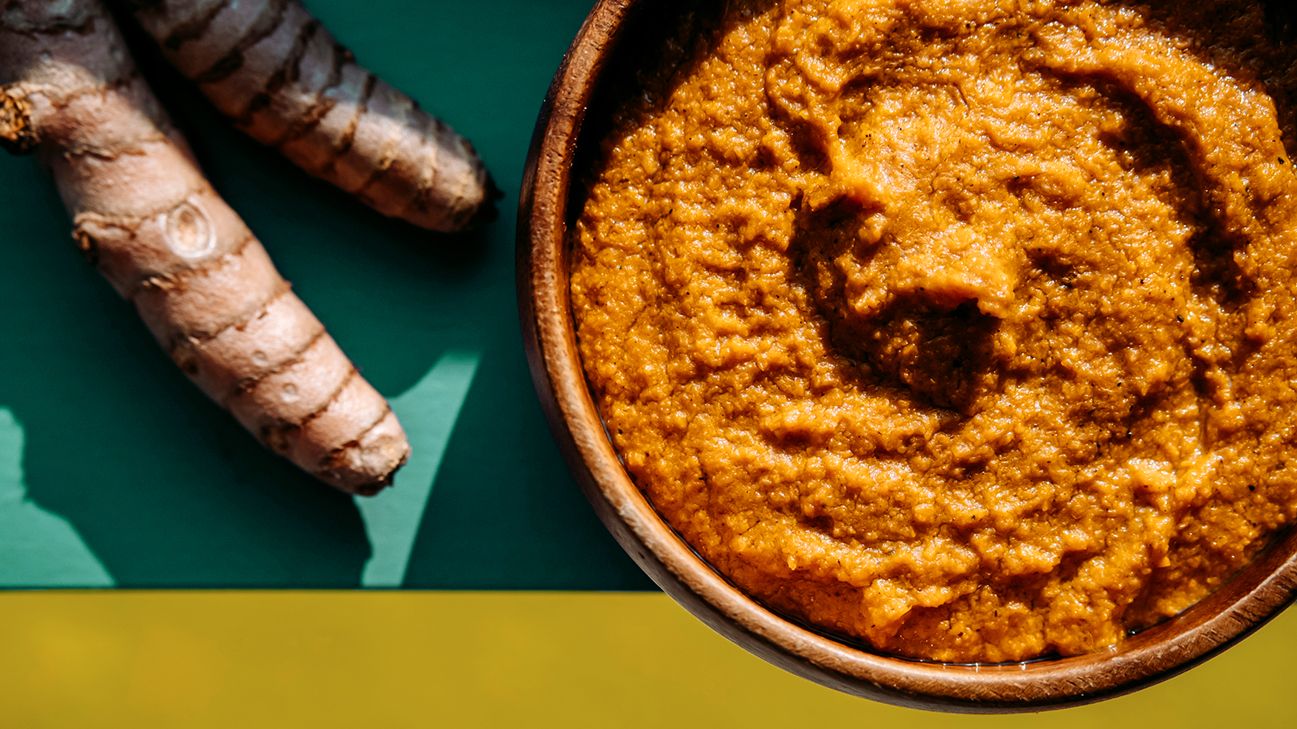The familiar squiggle of bright yellow mustard that runs down a ballpark frank gets its color from turmeric, a bright yellow spice and cousin of ginger that’s used in many Indian dishes.
But color isn’t the only quality that makes this superstar spice shine. Turmeric has long been used for everything from soothing digestive distress to relieving inflammation and chronic pain.
Ready to learn more? Keep reading for some reasons this incredible ingredient definitely deserves a spot in your spice cabinet.

Turmeric, which is made from the root of the Curcuma longa plant, gets its nutrient powers from an antioxidant called curcumin. (No, it’s not related to cumin!)
A 2017 review of studies noted that curcumin can aid in managing some oxidative and inflammatory conditions, especially when combined with piperine, the major active ingredient in black pepper.
And another 2017 review suggested that there may be potential for someday including curcumin as part of treatment plans for certain inflammatory conditions, though the research is still in its early days.
Some research suggests that turmeric could help keep your digestive system running smoothly, thanks to its ability to keep inflammation at bay.
In fact, one review of six studies suggested that curcumin could be a safe and effective option to help people with ulcerative colitis stay in remission when used alongside standard treatments.
It could also be useful for the treatment of irritable bowel syndrome (IBS), a condition that causes a long list of unpleasant digestive issues, including bloating, stomach pain, and diarrhea.
For instance, one small 2016 study found that people who used a combination of curcumin and fennel essential oil for 30 days experienced significant improvements in IBS symptoms and quality of life compared to a control group. But larger studies need to be done to better understand the benefits.
Several recent studies have suggested that turmeric could help prevent the growth of cancer cells by decreasing swelling and inflammation.
Interestingly, research from 2019 suggests that turmeric’s antioxidant powers may even help slow cancer growth and make tumor cells more sensitive to radiotherapy and chemotherapy.
Aside from its antioxidants, turmeric’s anti-estrogen compounds have the potential to help fight the growth of breast tissue tumors thought to be caused by estrogenic compounds found in food, pesticides, and other chemicals.
Still, more in-depth research in humans is needed to actually confirm any of these benefits.
In addition to enhancing your physical health, turmeric may even have a powerful impact on mental health to help keep you feeling your best.
A 2020 review reported that turmeric may improve symptoms of depression and anxiety with few side effects when used alongside standard treatment. But the authors also mentioned that these conclusions were based on a small sample size and that further trials are needed.
A 2015 study suggested that turmeric has potential to boost the effectiveness of antidepressants in people with major depressive disorder.
But there’s not enough evidence to show that turmeric should replace other treatments for depression, such as therapy or medications. Instead, it may be a good option when used alongside these treatments.
As if its antioxidant and anti-inflammatory effects weren’t enough, turmeric may even help slow signs of aging to boost brain function and keep your memory sharp.
Impressively enough, research suggests it could help block the buildup of beta-amyloid plaque in the brain, which could be beneficial for treating Alzheimer’s disease.
In some animal studies, it’s even been shown to improve short-term memory and prevent inflammation in the brain that could cause memory loss.
However, more high quality studies on the relationship between turmeric and brain health in humans are still needed.
In its bright yellow powder form, turmeric is great for adding a quick pop of color to your plate. With an earthy (but not super spicy) flavor, turmeric also brings a tang to curries and bean and rice dishes.
The benefits of this spice extend beyond dinnertime too. If you’re feeling creative, try using it as a natural dye for Easter eggs or baked goods, including breads, cakes, and cookies.
If the plain yellow stuff is nowhere to be found, try curry powder — a blend of turmeric and other spices like coriander, fenugreek, and cumin — as a stand-in.
Be sure to pair turmeric with black pepper to pump up curcumin’s antioxidant benefits. Black pepper contains that compound called piperine, which can boost your body’s absorption of curcumin.
Heat doesn’t break down curcumin, which means it retains its beneficial effects even after it hits the skillet. Even better news: Heating curcumin actually increases its bioavailability (your body’s ability to absorb it).
Putting turmeric at the top of your spice list
- Need a health refresh? Sip on these 15 “detox drinks”
- 10-minute scrambled tofu for egg-free breakfasts
- 11 slow-cooker recipes for fall because your Crock-Pot is feeling neglected
- 9 Buddha bowls to stay healthyish this year
- These fall lattes each have a secret ingredient your body adores
- 7 quick and healthy winter soups
- 22 popcorn recipes for movie night snack attacks
- 11 Whole30 smoothies for when you’re sick of making eggs

